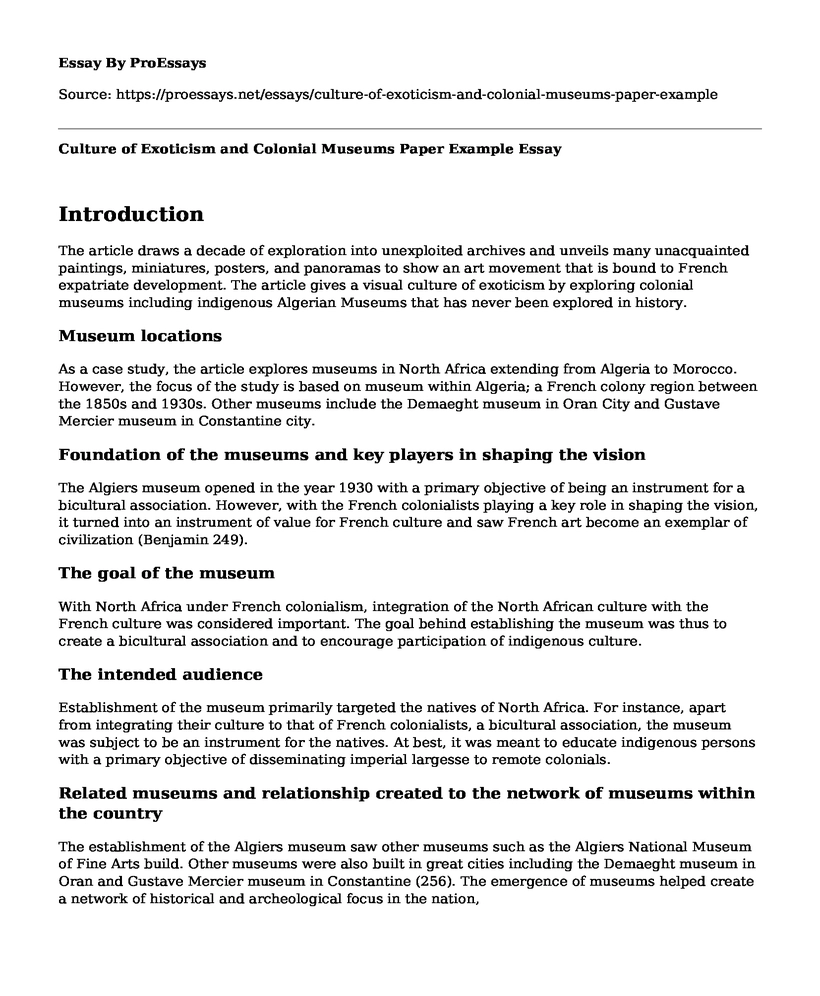Introduction
The article draws a decade of exploration into unexploited archives and unveils many unacquainted paintings, miniatures, posters, and panoramas to show an art movement that is bound to French expatriate development. The article gives a visual culture of exoticism by exploring colonial museums including indigenous Algerian Museums that has never been explored in history.
Museum locations
As a case study, the article explores museums in North Africa extending from Algeria to Morocco. However, the focus of the study is based on museum within Algeria; a French colony region between the 1850s and 1930s. Other museums include the Demaeght museum in Oran City and Gustave Mercier museum in Constantine city.
Foundation of the museums and key players in shaping the vision
The Algiers museum opened in the year 1930 with a primary objective of being an instrument for a bicultural association. However, with the French colonialists playing a key role in shaping the vision, it turned into an instrument of value for French culture and saw French art become an exemplar of civilization (Benjamin 249).
The goal of the museum
With North Africa under French colonialism, integration of the North African culture with the French culture was considered important. The goal behind establishing the museum was thus to create a bicultural association and to encourage participation of indigenous culture.
The intended audience
Establishment of the museum primarily targeted the natives of North Africa. For instance, apart from integrating their culture to that of French colonialists, a bicultural association, the museum was subject to be an instrument for the natives. At best, it was meant to educate indigenous persons with a primary objective of disseminating imperial largesse to remote colonials.
Related museums and relationship created to the network of museums within the country
The establishment of the Algiers museum saw other museums such as the Algiers National Museum of Fine Arts build. Other museums were also built in great cities including the Demaeght museum in Oran and Gustave Mercier museum in Constantine (256). The emergence of museums helped create a network of historical and archeological focus in the nation,
The collection and its formation
Little sensibility was directed toward North African Art. Instead, Hazards resorted to collect French art from the sixteenth century to the nineteenth century for the Algiers museum. With an idea of building a modern collection, he collected; modern French paintings after the year 1850, French sculpture from the later nineteenth century to 1930 and the French Orientalism to 1930. The collection later contained French landscapes (263).
Changes in museums with independence
With independence came the transformations of museums based on collections and displays. The museums ceased to be institutions for which the French colonialists endowed themselves with monuments that fostered self-improvements and identity. Museums displayed modern indigenous and exotic paintings and sculpture.
The relationship between museums and colonialism
Museums are a reflection of colonial cultural life implanted in a given setting. For instance, for years the Algiers museum was an icon of the colonialist's society with the French culture dominating and benefiting; an aspect the dubbed the country 'An Algeria that was French.' In relation to colonialism, museums are thought to be instruments of instructions that subjected native to being subjects rather than creating a memory of self-awareness.
Overall teaching from the history of museums
Museums are meant to create self-awareness by keeping memories. They are also meant to be institutions for fostering historical as well as the archeological focus of countries while also valuing the historical backgrounds from which a nation developed.
Work cited
Benjamin, R. (2003). Orientalist Aesthetics: art, colonialism, and French North Africa, 1880-1930. Univ of California Press.
Cite this page
Culture of Exoticism and Colonial Museums Paper Example. (2022, Aug 15). Retrieved from https://proessays.net/essays/culture-of-exoticism-and-colonial-museums-paper-example
If you are the original author of this essay and no longer wish to have it published on the ProEssays website, please click below to request its removal:
- A Response to the City Lights Film
- The Rise of Internet News Has Crippled the Print Media: Paper Example
- Change, Growth, and Development of Wing Biddlebaum/Adolph Myer and Kacem
- Research Paper on Cultural, Political and Social Identity of the South Asian People
- Critical Essay on Madame Ginoux in Cafe de la Gare: Paul Gauguin 1888
- Film Analysis Essay on Better Life: Undocumented Struggles of an Immigrant Father & Son
- Essay Example on Sonny's Blues: Music, Race, Suffering, and Hope







